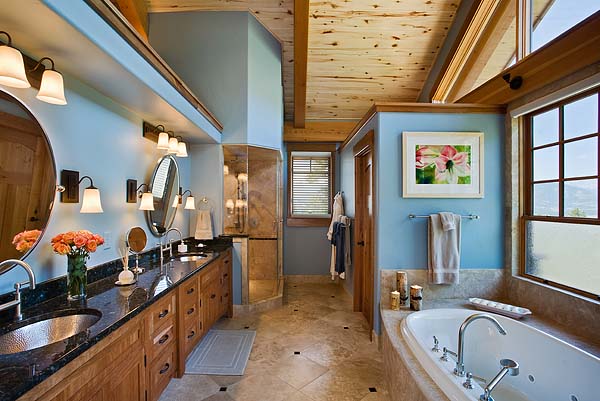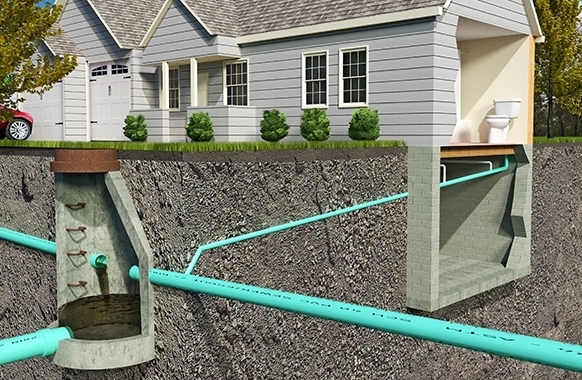In large cities and suburbs, sewage effluent typically travels through a municipal sewer system and into a water treatment plant run by the local public health department. In some places, however, especially remote rural areas where there may not be an extensive sewer system in place, septic systems do the work of both sewers and treatment facilities.
Most people probably don’t think about their septic system until something goes wrong and you have to call out the septic tank installers to make it right. The truth is that knowing a little bit more about your septic system can help avoid problems in the future that could have a huge impact on public health and the environment, as well as the value of your property.
What are the parts of a septic system design and how do they all work together? Let’s take a closer look.
What Are the Parts of a Septic System and How Do They Work?

Photo Courtesy of Mountain Timber Design
There are five parts to a standard septic system.
1. A pipe from your home. All of the wastewater from your home exits the main pipe (septic drain) into your septic system. This includes everything from the water you drain from your sink after washing dishes to what exits your toilet when you flush. If your home has a basement, it’s usually pretty easy to locate this pipe in case there are any problems in the system.
2. The septic tank. This is the largest part of the treatment system and is buried underground. It’s usually about a foot below the surface so it’s hidden, but can still be periodically accessed when needed. It’s usually about ten feet or so away from the outer wall of the home. The size of the septic tank is based on the size of your home since larger homes will likely produce more waste. Residential septic tanks typically hold between 750 to 1250 gallons of wastewater.
The water dwells inside the septic tank to allow solids (which is called sludge) to separate to the bottom, . While this happens, grease and oil simultaneously separate from the rest of the effluent and float to the top, forming what is called scum. The septic tank is designed in such a way that the sludge and scum can’t escape the sewage treatment.
3. The distribution box. Water is pushed out of the septic tank every time new water enters it. Where does it go? Into the distribution box which guides the water so that it’s evenly divided into perforated pipes that take it to the leach field. Sludge and scum stay behind as the water continues along in the process.
The distribution box is much smaller than the septic tank though it’s also located about a foot under the surface in case it needs to be accessed.
4. The leach field. The leach field is also called the drain field. Water leaving the septic tank through the distribution box is considered partially treated when it enters the leach field. It flows through perforated pipes which are usually surrounded by rock, dirt, or gravel or covered with mesh to prevent the holes from getting blocked. This is important to make sure that the water is evenly distributed through the leach field.
5. The soil. The water that soaks into the ground from the leach field uses natural bacteria in the soil to remove the harmful components that remain. The treated water then works its way through the soil and joins the natural groundwater.
Care and Maintenance
You might assume that this system functions on its own without any maintenance or that you don’t have to intervene unless something goes wrong. Unfortunately, without routine maintenance, there’s a greater chance that something will go wrong.
Here are some things you should do to keep your septic system working smoothly:
How Do I Know if There’s a Problem?
Failing to do regular maintenance of your septic system can cause a lot of problems but you can usually catch them before they become catastrophic if you do regular assessments.
It’s usually pretty easy to tell if a problem is developing. The first thing you’ll usually notice is a foul smell. Clogs can cause everything to back up so that the waste isn’t being broken down like it should be, leading to increasingly bad smells. Another thing you shouldn’t ignore is puddling water in your leach field, which is also a sign that the system is backing up.
If you do encounter a problem, do not try to handle it yourself. The waste in a septic system contains a lot of harmful bacteria and should only be cleaned up and repaired by a professional who has the right equipment. Remember, proper maintenance can help keep all the parts of the system working properly. A yearly inspection can prevent a lot of costly problems down the line.

My brother who came over for dinner last Monday, told me he was moving into a new home with his wife and children. He began looking into installing septic systems to avoid any issues with the water in his new home. I offered to help him look into it and that’s where I found your amazing article, I am most fond of where you wrote about that if you neglect to remove the sludge, it will move out of the septic tank into the distribution box and further into the leach field over time, which could cause the entire system to fail. This is a great point you made, which I’m sure those interested in getting these systems installed will be happy to keep in mind. Thanks for this! I’ll share this with my brother in a bit!
I appreciate you letting us know that it is advised to have the sludge pumped out every few years to maintain the septic system well and ensure nothing major goes wrong since we inspect it routinely. It’s been about three years since I moved house in Bernalillo, and it seems like I need septic pumping soon since we keep experiencing slow drains at home these days. I’ll take note of this while I look for a septic pumping company in Bernalillo to hire for maintenance soon.
Thanks for your comments!
Last Monday, when my brother dropped by for dinner, he informed me that he and his family were moving into a new house. He started investigating septic system installation to prevent any water-related problems in his new house. I am especially fond of the part where you mentioned that if you don’t remove the sludge, it will eventually move out of the septic tank and into the distribution box and leach field, which could lead to the failure of the entire system. I offered to help him investigate, and that’s how I came across your fantastic article. This is a great point you made, which I’m sure those interested in getting these systems installed will be happy to keep in mind. Thanks for this! I’ll share this with my brother in a bit!
Thank you for your comments!
Thank you for your comments!
It’s excellent that you clarified that, even though we regularly inspect the septic system, it is recommended to have the sludge pumped out every few years to keep it in good condition and make sure nothing significant goes wrong. I’ve lived in Bernalillo for about three years, and since we keep having slow drains at home, it looks like I’ll need septic pumping soon. I’ll remember this the next time I’m looking for a Bernalillo septic pumping business to hire for maintenance.
Thank you for reading!